Turkeysong, The Year in Pictures and Video, 2014
THIS BLOG IS RETIRED, I’VE MOVED TO SKILLCULT.COM
ALL THE OLD TURKEYSONG POSTS ARE THERE AND MORE, CHECK IT OUT!
The short version of this year: Felt like shit most of the year, didn’t get a lot done, stopped growing stuff intentionaly for the farmer’s market due to unreliable health and too many wasted crops, switched most of my energy and time over to trying to figure out health issues which occupies about 2 to 4 hours or more of research on most days and much of my thoughts. But, even though I sat on my ass for about 80% or more of the great majority of my days, the pictures I took this year do show that I did get out a little bit.
I’m in a full on war to regain my health. It takes a lot of thought and time, so I haven’t done as much cool stuff as usual. Once I figure that out, I hope to be a fountain of useful output, but until then I’m running on fumes. This year, I was really just getting by most of the time with little spurts of energy here and there which I generally use to do something interesting so I don’t go fucking crazy, often with piles of dishes and laundry as a result. Give me a choice between a pile of dirty laundry with a pile of charcoal, or just a pile of clean laundry, well… I’ll just be adding some charcoal stained clothes to that dirty laundry pile son. Let me tell you, a life of leisure is just not for me!
The spring ran on through the worst drought anyone can remember. It was pretty slow, but there was still more water than I ended up using. The spring really does make it all possible. I feel like I should build a shrine or something. Seriously amazing.
I actually got around to filling my deer tag this year! Skippy the deer is mostly eaten up now, and good riddance. He was busting down fences, messing up fruit trees and generally being a juvenile delinquent. I was half expecting to find graffiti somewhere… DEERZ RULEZ! on the water tank or some shit like that. The plan was to do a year long educational video series following the processing of Skippy into all kinds of cool stuff, but it proved too large of a challenge to pull off on my own and just getting him cleaned and in the freezer had to be enough at the time. Maybe next year.
My ex partner and currently business and land partner Tamara Wilder has been back more this winter bringing some help in the form of work traders and such. It’s a bit of a challenge to have people here after living in solitude for a year and a half or more and I’m generally not up for managing anyone, but maybe some stuff will get done.
I’ve been a little more focused this year on video and hope to continue that trend. I still want a better camera, but I have an okay consumer camcorder I can use for now. I am pretty excited about the great potential of video and the opportunity to reach a lot of people around the world with it. You can visit my fledgling youtube channel here. It’s always helpful to get comments, likes and subscriptions, hint hint! So this year it’s two for one, The Year in Video and The Year in Pictures. Or more like two for none, what a deal!
I’ll let the images and captions tell the rest.
Watch in HD if your rural connection is fast enough.
_______________________________________________________________________

A 6 year old apple tree frame-worked to a new variety. Edward’s Fine Winter just didn’t perform well enough, so I changed it over to one of the Etter red fleshed apples. This was taken in spring. When I grafted it, the tree was already starting to flower. Yes, that’s okay to do.

The same frame-worked tree in September. The few apples on there are of the original variety. As you can see, regrowth is rapid when pushed by a healthy established tree frame and roots. The Naked Ladies (Amaryllis Belladonna) were headed to farmer’s market where they seem to be fairly popular. Just a bonus of the fruit tree bulb understory experiments.

Persimmon tree planted to Amaryllis bulbs. This planting must be around 5 years old now. The chickens get in there and tear things up a bit, so they might be contributing to weed control, but there were literally only two or three weeds in there last season with no weeding on my part. I did weed it for the first 4 years though.

the same tree in summer. Except where the chickens scratched them away, the dead leaves make a nice mulch for the summer and die back by about June 1st to 15th. This tree is not thriving, but it doesn’t get any water and has never been very vigorous. Other trees should be more telling in regards to what degree the bulbs are competing with the tree for nutrients and water. So far, most of them don’t seem any worse off for the arrangement.

I made this apple tree into a frankentree for my neighbors last winter. It was dubbed the Bride of Frankentree. Here I’m doing the prep work, pruning everything back to stubs.

The bride shorn and ready for grafting. The part on the left was retained as the original variety. I think we put on about 75 grafts and 25 or 30 varieties, but I don’t recall for sure. This may look drastic, but I think if the tree is healthy and the grafter has confidence in their ability, and in the quality of the scion wood, it is okay to graft a healthy tree over all at once.

Just about finished grafting, after which the bare branches were painted white. Note how close the scions are grafted to the larger framework of the tree. Also, that the scions are long, 8 buds or more if there is enough scion wood.

I don’t have a current picture, but this is the bride early in the season. It grew out nicely. Almost all the grafts took and just a few loses to the usual perching birds, cicadas and wind.

I carved some nice spoons and spatulas this year from spalted Big Leaf Maple and Madrone. When I come across some nice wood, I blank out billets with my hatchet and store them for later use. The rough shape is made with a hatchet and the rest is finished with a knife, rasp and sandpaper. They sold pretty well, but I don’t really do it for the money, because it doesn’t pay well when using hand tools and rough wood. A band saw would speed things up, but where’s the fun in that?!

this year I got it together to print all my seed pockets instead of writing on them. I also posted a how to video on making them, which I may re-do for quality reasons, though it’s functional enough.

Seeds of Ruby Streaks, a red Mizuna type mustard green. This hasn’t turned out to be a very good market item, but I eat quite a bit of it sauteed in butter. It sure is pretty.

Bulgarian Giant Leek seeds.

I continue to be amused by frequent hits on my How to Grow Huge Ass Leeks post from people searching for huge asses, or how to grow a huge ass. I guess in this case huge just wasn’t enough. I have to wonder if any of them have actually ever read the article.

Newly dug bed for growing out red fleshed apple seedlings. The white color is from ashes and oyster shell.

the new crop of apple seedlings overgrown in the flats as usual. These will be grafted onto dwarfing stock this year. I just planted the seeds from last year’s pollinations. I’m not sure how many more batches I’ll do. I may just do one more year and call it good. I’ve only got so much room and resources to grow out apple seedlings just because it’s cool, but there are a few more crosses I’d really like to make.
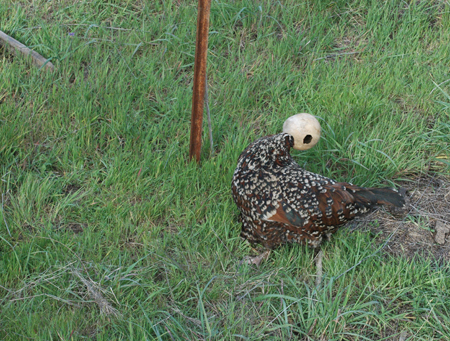
This chicken got it’s head stuck in a gourd and was running around bumping into stuff. It was so funny I had to run and get my camera before I rescued it.

this was a tree planting site on which I did a charcoal burn. I dug a large pit, burned the charcoal, crushed it and re-buried it in the pit as it was refilled. This was one of several pit and trench charcoal burning experiments I pulled off this year. final amended area is about 8 foot diameter circle, 2 feet deep.

Reburying the pit with charcoal mixed in. The tree has done very well in spite of a serious drought. It was plump and flushed deep green all year. I mixed in some urine as I went to charge up the charcoal. otherwise, it will soak up all the nitrogen during the first year leaving none for the tree.

More trench burning of charcoal from the youtube video I posted on this method. I’m stoked about it. It seems to work very well, and it’s fun. Thanks to reader Lars for pointing me in this direction.

When discussing biochar, people are often skeptical about the alleged durability of charcoal. This seems to prove the point pretty well. It’s a fossil that my friend found with both petrified wood and pieces of charcoal embedded in a stone matrix. Is that old enough for ya?!
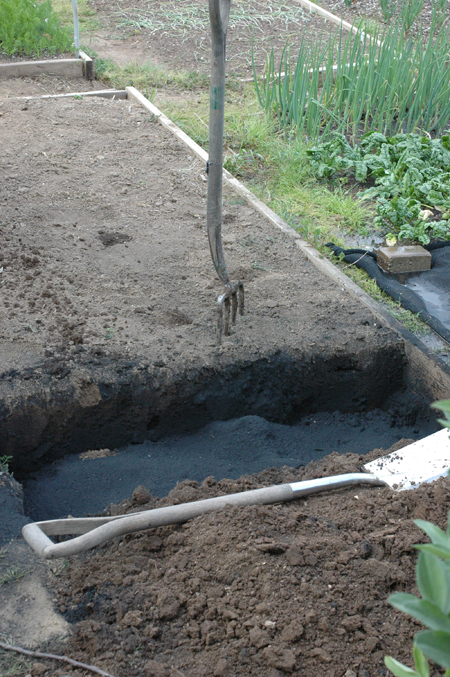
Digging biochar into a bed. This bed performed very well compared to most of the rest of the garden. In fact, my other biochar amended bed and this one were the best performing beds. This one was done as an experiment. Half the bed is 10% charcoal to 20 inches deep and the other half is 20%, but only dug in 10 inches. In other words, same amount of charcoal in each end of the bed just mixed shallower or deeper. No observable differences so far. I have quite a bit of charcoal stockpiled and hope to get a couple more beds prepared this spring. I’m planning more char to greater depth on the next bed and it will be prepared all at once by digging everything out to at least two feet, getting rid of most of the rocks and incorporating amendments as the soil is put back. That may seem like a lot of work, but given that it should result in a permanent improvement it doesn’t seem so bad, especially given the large amounts of organic matter that most people dig into their beds yearly and which is constantly disappearing. Not that charcoal is a total replacement for organic matter, but it does have some important functional similarities and will probably ultimately either reduce input requirements, or result in a better use of them.

One year of growth on an apple tree after dis-budding and notching to select branches. This method appears so superior to what is commonly recommended that I am anxious to do an article or video on it. It may be a little hard to visualize in 3 dimensions from a 2 dimensional picture, but this tree gave me 4 branches in four different directions in just one year. I haven’t taken a current picture since it has grown out another year, but the tree will be grafted over to something else, on account of the scion wood being mislabeled. It was supposed to be Golden Harvey, a super sweet long keeping cider/eating apple that I was all assed up about. It turned out to be some bitter foamy cider apple of no account instead. Back to searching for the real Golden Harvey……. “Independent of being one of the best dessert apples, it is also one of the best for cider: and the from the great strength of it’s juice, the specific gravity of which is 1085, it has been called the Brandy Apple.” (Hogg- 1851) ………… “when, however, in a good season, the sweeness and aroma are happily retained, the cider is as rich as it is potent, and tradition tells that it has not unfrequently been exchanged, bottle for bottle, for the best old port wine.” (1878)…….. “”Flesh Yellow, firm, crisp, juicy, sugary, rich and aromatic flavour. “the Brandy Apple, in a warm and favourable season, is perhaps the most delicious of all dessert apples.”” Ripening in December, it will keep until June, but requires careful storage.” Sounds awesome right? I want that apple!

This picture shows the more rapid progress of a bud which has had a small notch cut above it. note that it is further along than the other buds. Supposedly that is because the notch disrupts signals from the top of the tree which otherwise would inhibit it’s growth, but also possibly because it directs nutrients into the bud instead of letting them pass up the tree. Whatever the physiological mechanism, it works. After taking this, I removed the buds I didn’t want to grow into branches. I had originally left all buds just to prove a point, but there is no doubt that removing most of the buds results in more growth in the remaining buds. This is a sour cherry. Sweet cherry has not responded at all well to notching and dis-budding. Apples and pears respond very well.

This jar of fermented Sicilian style olives was about 4 years old when I opened it and took the olives to the Olive Odyssey festival to share as tasters. They were very good. Long storage potential is one great advantages to fermenting and then storing in the fermenting jars. A technique which I will no doubt write more about some day.

Chicken broken down into potentially edible parts. I was experimenting for a minute with eating as much of a chicken as possible. Those two things on the table to the right of the chicken that look like dead salamanders taste awful. Don’t eat those! I don’t know what they are, but they taste the way chicken poop smells. I also made several attempts to process and eat the intestines , but they also taste like chicken poo no matter how much cleaning, scraping and experimenting. I gave up on the intestines. The actual sphincter, or chicken butt hole, lower right, is quite tasty though. That still leaves the great majority of the chicken imminently edible. A lot of the chickens have been on death row for a while as the flock has grown beyond the carrying capacity of the land. Lucky for them I haven’t had enough energy to get around to slaughtering very many of them. I accidentally shot one of the hens though, because a bout of uveitis in my eye had affected my vision to the point that I thought it was a similar looking rooster. A tragedy maybe, but a tasty tragedy.

Finishing some oak tanned leather that was started in 2013. Here I’m scraping over the flesh side one last time to remove bits of tissue and oak bark.

My friend Talcon oiling the flesh side of the leather with tallow before we paste it down to a piece of plywood for finishing and drying.

In this step, the leather is smoothed out with a rounded polished slate. This removes wrinkles and dents. It also sticks the hide to the board because of the tallow pasted over the flesh side.

After setting the skin to dry up on saw horses, the chickens jumped up and walked all over it, so I had to re-slick it with the slate to smooth it back out. otherwise it would dry with these permanent marks, just like when leather is tooled to form patterns. Mayvbe it could be like faux distressed leather.

I’itoi onions (pronounced E E toy) which I started selling on ebay in the spring. They are exceedingly rare, but the many packages I sent out this year should help change that. It is a very small onion that is grown by the O’odam in the Southwest U.S.. Thought to be brought by the Spanish invaders, it is well adapted to the droughty Southwest climate. It quickly forms large clusters of very small shallot like onions which can grow perennially as chives or be harvested and replanted to make small onions. They are awful small, but they’re pretty neat and very tasty.

I made quite a few batches of bay nut toffee this year. about 50/50 pasture fed butter to sugar, a little salt and vanilla, and bay nuts. I’m still refining recipes, but it has been declared good by all tasters!

These are not chocolate, they are ground roasted bay nuts with sugar and orange peel. They look like chocolate and melt like chocolate. They also taste more like chocolate than anything I’ve ever tried, but they are still very different and their own thing. These turned out great, but they undergo a process of degradation and separation the same as chocolate will when not subjected to the process of tempering, and usually with the addition of lecithin as an emulsifier. Eventually most of the fat coalesced together over time leaving the dry powder separate. I hope to work on experimenting with tempering it like chocolate, but I need access to a mueller and hopefully a tempering machine, though I could do the tempering by hand with enough patience.

Netted bed of lettuce and scallions going to seed. I have to net most of the greens from birds, at least when they are young. This is mosquito netting, which is pretty cheap, but it hasn’t held up that well in the sun. Otherwise, I like it.

Titan’s Glory iris. This iris does everything big. It has large rhizomes that spread quickly and large flowers that bloom profusely. All around an excellent variety.

Oriental Poppy. I planted 3 varieties of these as experiments in tree understories. They haven’t performed that well in that capacity, but they are still very cool and extremely rugged. I tried to kill some and the just keep coming back. The flowers are very large, up to 8 inches across (6 more realistically) and they form large perennial clumps that can live for decades!

getting OCD with some freshly rinsed artichokes. These were made into canned artichoke hearts.

William’s Pride. This is a very promising early apple. Here photographed in July, it is in eating around late July and early august here. It is surprisingly good for that early of an apple competing with chestnut crab for best early apple (though that isn’t really a fair comparison since they are so different). It is quite large, very crunchy and crisp, has a surprising amount of tannin and pretty complex flavor. As you can see, it takes a high polish too.
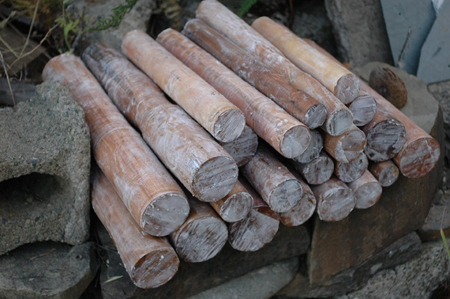
Madrone billets for making stuff on the lathe. I got my lathe up and running and managed to make a few awls and willow cleaves before the space it was set up in got re-purposed as living space. These Madrone billets were split out of a neighbors fallen tree, hewn into a rough shape with a hatchet, rough turned on the lathe and then oiled with tallow for seasoning. I try to stock up on wood like this when it’s available.

This is a willow cleave made from the above madrone. It is for splitting willow into 3 strands used in certain types of basketry. The process can be done by hand, but it is much, much slower. It’s not a tool that many people need. I wouldn’t be surprised if I’m the only person making them in the U.S. They are for sale on Etsy just in case you need one.

Madrone awl. I started an Etsy account for Paleotechnics and listed my awls, willow cleaves and some jewelry type stuff. Hopefully more to come in the future. These are ideal for braintanned buckskin (pictured) and a lot of the type of leather work I do.

Black Sage flower spike. I like these, they have a cool architecture. Bugs love them too. The Latin name is Salvia mellifera, thousand flowers, and it lives up to the name.

Baby fence lizard. They start coming out in July. They are born with large heads so they can start eating right away.

a miniature drum necklace, a little bigger than a quarter. goat rawhide, elderberry wood and brain tanned buckskin. More Etsy product

Reliance grape, which I’m increasingly impressed with. Short video review HERE.

large store egg v.s. small turkeysong egg. Note the much larger yolk in my significantly smaller egg, let alone the rich color. The white is also clear whereas the commercial egg’s white is yellowish. I’m always shocked when I see how sallow and ill formed store eggs are. Organic and “free range” account for very little in commercial eggs since the birds still have the same crappy economical diet, it’s just organic instead of conventional. that’s understandable though. If we demand cheap eggs they have to be produced cheaply and someone will do it. The yolks are undersized, pale and contain more inflammatory fatty acids DHA, Arachidonic acid and omega 6 fats from a steady diet of grain. They probably aren’t actually capable of supporting life, a chick’s or ours. I was running low on eggs, so I bought a dozen, but I ended up just eating the whites and tossing the yolks. Last week I set up a light on a timer to trick the hens into starting to lay again and got three eggs yesterday and four today…whew!

I’m finally getting some pears on my small trees. The big red one is Souvenir Du Congres. it was very good. Wish I had one to eat right now. The others are bartlett from a tree I grafted using wood from an old homestead tree at the top of the driveway. I got some asian pears too and a few winter pears by the name of Passe Crassane, which are stored cool and brought in to ripen as needed.

The first soil enrichment, biochar, latrine, experimental pit/trench/hole is finally dug and slowly accumulating otherwise unused organic matter. Yay, progress! I had some help digging, thanks to Will and Gretchen. I charred some accumulated garden slash in there today.

Another vulture taking flight. He was sunning himself on the garden gate. They hang around for the food scraps that I throw out for the chickens.

View from up the drive a bit, showing the type of country here, which is pretty diverse. The green patches in the meadow are harding grass, very difficult to control or eradicate. the caged trees are olives. The gully on the right has been planted to figs, french prunes and basket willow. The soil in there stays damp all season.

Dusk view toward the coast on the other side of the ridge. The ridge directly above Turkeysong divides two watersheds.
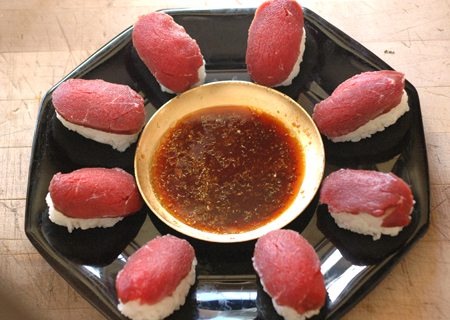
Venison sushi, my new favorite way to eat venison. The meat is previously frozen, which should take care of parasites if that were an issue. I’ll be cleaning my deer more carefully next year to maximize sashimi potential. I’m making some for lunch in a few minutes, yum.
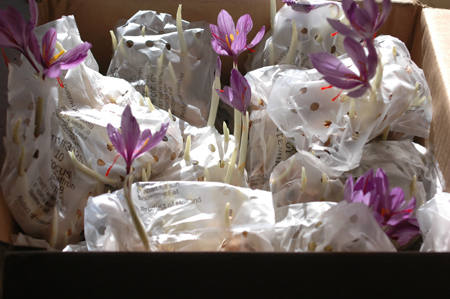
I scored some incredibly cheap saffron bulbs this year. I sold some on ebay to pay for the order, planted some in random field plantings as an experiment to see how long it takes the gophers to eat them all, and put some in a garden bed to multiply for later. As you can see, I was a little tardy in planting them, but it worked out in the end.

This is a knife that an intern/helper gave me. I was already considering buying this exact knife for carving the flutes in my willow cleaves. I’ve been geeking out on knife handles and had this idea for carving the handle for increased grip texture. So far I like it a lot, but I’ve yet to use it for any long period of time. If it causes any kind of discomfort with longer use, I’ll just round the high points a little with fine sand paper.

My friend brought over this knife to make a sheath just around when I was working on a video outline about knife handle design for multifunctional knives. So it turned into a bigger project and I entirely reshape the handle first, which was filmed as a video segment. The sheath is made from 4 different leathers, stiff bark tanned wild boar on the inside, soft bark tanned goat on the outside, a bark tanned horse hide welt to protect the stitching and braintanned buckskin sewing thong. It turned out pretty sweet. Just for the record, I’m not a big fan of this mora style of blade for general purpose knives, but that puts me in a minority among the primitive skills crowd. I absolutely love them for working with wood, I just don’t like them as carry knives or for skinning and butchering or whatever else I get up to that isn’t wood carving.

Bark tanned bracelet, more Esty product
Some stuff I think is cool this year:
Gokhale method of posture. This is different that any other kind of exercise, stretching, yoga etc… It is based on the idea that there is a basic correct type of posture for humans (which is probably a little different than what you’ve been told), and it really more to do with how you sit, lie, walk, live and move your body than exercises, though there are exercises. It also requires an attitude adjustment. Everyone I’ve turned on to it has been very enthusiastic and it has helped me a lot. This is really for almost everyone, but certainly people with any kind of posture/pain/joint issues should check it out. Classes aren’t cheap, but the book is excellent and a great place to start.
Ray Peat. Ray peat might best be described as a renegade biologist and science historian. He has his mind in all kinds of things, but with a focus on nutrition and hormones, with metabolism being at the center of the picture. Peat is one smart cookie and possesses a vast store of knowledge that he can pull out on demand. It he always right? I doubt it, and I’m very unsure you should eat like him, but prepare to have a lot of things you assume to be given truths called into serious question by someone with a rare mind that thinks way outside the box. Try on for size: CO2 is much more than a waste gas of metabolism and you should make and retain as much as possible, serotonin and estrogen are primarily destructive substances in the body and there is no such thing as estrogen deficiency, and essential fatty acids are not only not essential, but essentially toxic and more of an unfortunate natural occurrence that we have to adapt to. Often includes the history of where science/medicine went wrong in adopting a certain dogma, and the influence of industry in corrupting scientific research and medical practice. This is not light reading and listening, but he dumbs it down for us as much as possible. Warning, Ray Peat can be a deep rabbit hole and lead to food neurosis and extreme self experimentation in a certain type of personality.
Michael Mews. This stuff is absolutely fascinating. There are several dominant theories on the prevalence of modern facial malformation and poor dental development, which has become nearly universal these days. How many kids do you know that are not getting braces around age 13? I can’t think of any. The genetic explanation is pretty much bullshit, but convenient to point to for medical professionals who don’t know the answer. Michael Mew’s point of view deals with oral habits and environment. The third common view is diet via Weston Price, which probably has considerable substance, but is clearly not the total answer. Michael Mews is really putting out some amazing stuff about an issue that now affects nearly all modern people. If you have kids under 18, this is a must watch before subjecting them to the mutilation and idiocy that is standard practice orthodontics. It’s also just plain interesting.
See you around homies! Have a great and productive year!
10 Comments »
Leave a comment
-
Recent
- Potato Onion Video and Multiplier Onion Giveaway
- Deer Hide Ruined by Poor Skinning
- Frankentree is Quite a Sight, With Over 85 Varieties Fruiting This Year! Wow!
- Potato/Multiplier Onion Giveaway and New Site
- Taste Testing Seven Summer Apples, Head to Head
- How to remove back strap sinew without wasting any meat
- Skinning Deer and Goats for Perfect Hides and Carcasses
- Peeling Oak Bark for Tanning Leather and Apple Breeding Update
- Two Sweet Crabs That Don’t Pinch! Trailman and Centennial, Delicious Super Early Crab Apples,
- A Video Tour of my Amateur Apple Breeding Project
- Why I’m Not Selling at the Farmer’s Market Anymore
- Virtual Garden Tour and Seed Packet Give Away for Subscribers
-
Links
-
Archives
- September 2015 (4)
- August 2015 (3)
- July 2015 (4)
- June 2015 (1)
- May 2015 (1)
- April 2015 (1)
- March 2015 (1)
- February 2015 (1)
- January 2015 (2)
- October 2014 (2)
- September 2014 (2)
- August 2014 (1)
-
Categories
-
RSS
Entries RSS
Comments RSS



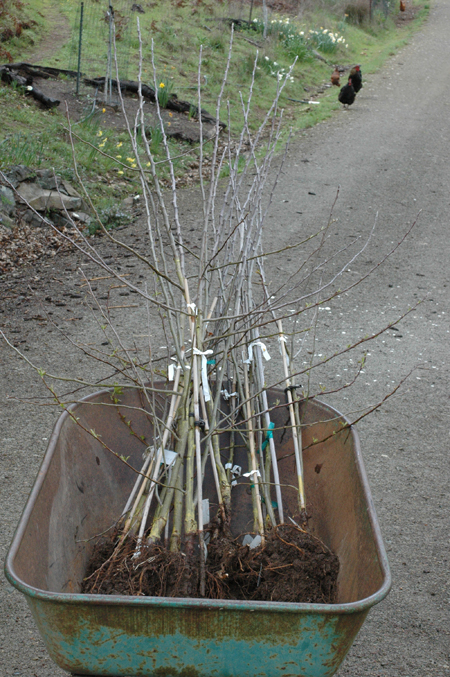






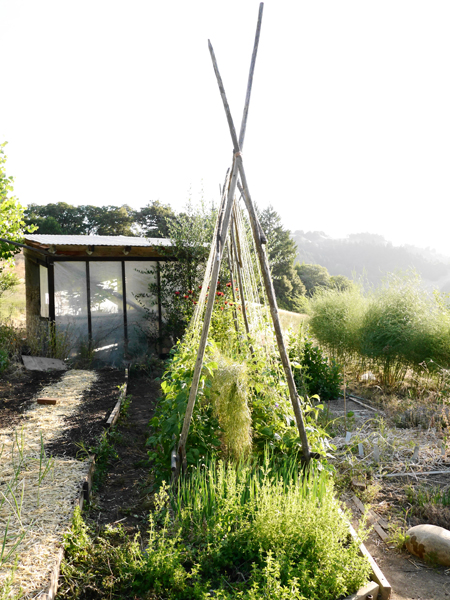

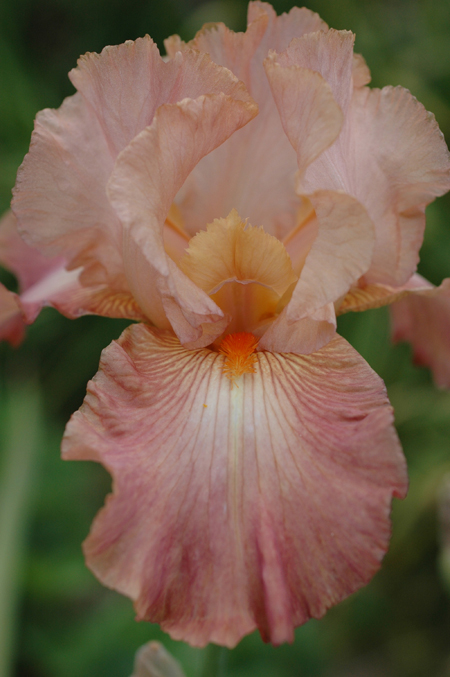


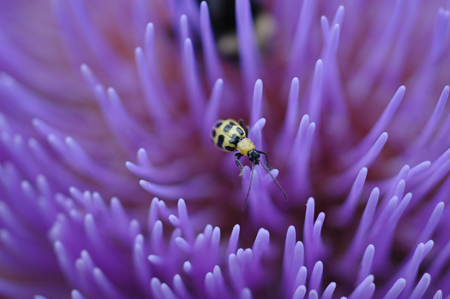








Really enjoy reading you emails, one of the few that get read straight away.
I’ve been told raw venison was a hepatitis E risk although that maybe only a UK problem.
Grew Bulgarian giants this year after reading about them on your blog, they are excellent if a little susceptible to rust.
I’ll check into the hepatitis thing, thanks. I have had real problems with rust on Bulgarian Giant in some years. Other years there is none at all. It seems to either be really bad or none. I think planting them out later might be the key here, but I’m not really sure yet. mostly, I’ve just been so behind in planting the last few years that the leeks always go in late and I noticed that I’ve had no rust.
SUCH AN AWESOME POST THAT IT NEEDS AN ALL-CAPS CHEER! Dude, awesome post. And I think you get more done being in shit health than most people do being all prime. Great stuff.
Well thanks for the vote of confidence. I really don’t get much done though, it’s an illusion created by the fact that I do mostly particularly interesting things instead of doing my laundry and dishes. Although I’m going to do my dishes now. I am. I’m heating the water right now. And I’m going to sweep my floor toward the end of the month some time! I am very efficient though. That helps. I’ve been playing with some OTC hormones and other stuff, mostly via Ray Peat, and I feel like I have a chance at closing in on the health stuff. Then just you wait homegirl!
For someone who sat on his ass for 80% of the year…you put the rest of us to shame. What exquisite beauty that sweet soul and brilliant mind of yours pours forth despite the challenges your body presents. Thanks for sharing so generously and with such humor! Fuck the dishes and laundry…they can wait!
Thanks Kate. I meant that 80% literally, but I do kick some ass when I’m up and about. Hope to cross paths with you sometime soon!
Thanks for the great post and video
The dead salamanders are quite positively the chicken’s double cecum, so it’s no great wonder they are not tasty. I do eat most of the intenstines though – turned inside-out over a knitting-needle for cleansing, then fried in fat with spice and most of the other internal organs. I’m not sure if it’s worth the bother. I do it only if I’m not in a hurry.
Another thing – if you ever get to post the part of the deer butchery video that shows the removing of the backstrap sinew in more detail it would be very appreciated. I remove a lot of goat backstrap – probably some 50 goats yearly – and never seem to get to the elegance you seem to have acquired with it. and I say it after reading the sinew removing chapter in your buckskin book (which did help a lot, by the way, so thanks again).
And last – I am envious of your multiplying onion varieties, both the potato and those new small ones whatever they are called. Nothing of the sort even exists in Israel, and I know of no legal way to deliver it from overseas. growing onions from seed is a headache I would love to be rid of.
Hi Nimrod: I wasn’t able to get all the poo taste out of the intestines and by the time I scraped them down, there just wasn’t a lot left anyway. I could see frying and spicing them a lot could help, but it doesn’t really seem worth the trouble under my current circumstances. I figured the salamanders might be some kind of kidney like organ. One of the worst things I’ve ever tasted.
I hope to do the full deer video sometime, maybe next year if I get a buck and can get someone to help me out. It may be that removing goat back strap is just not as easy. I’ve done a lot of goats,, especially in the last 10 years and don’t remember them being any harder, but then that is the kind of thing I’d forget. 50 a year is pretty epic. Goat skin is great stuff. It helps to have a high quality carbon steel butter knife with a very thin blade for backstrap. This only describes about 1 in 50 butter knives in America, but you can find them if you look. If it’s thin, it will work a lot better even though it’s too dull to cut anything. It probably looks more elegant at high speed. It’s never super slick, just because of the nature of the thing. Animals aren’t made to take apart after all, they’re made to stay together.
I still do leeks and scallions from seed and was growing some onions from seed for market. I don’t mind too much starting them from seed if I want large onions, but the multipliers are neat. You do have to grow extra though, since you’re saving part of the crop every year to replant. No free lunch as they say.
Hey there, awesome post.
I was wondering how you carved (and what tool) the wavy texture into the mora knife?
thanks,
-chris
Hi Chris: I just used a small detail knife. Actually, it was something like an exacto knife, because that’s what was handy. If I could have, I would have just used the knife I was carving. As far as the process, I drew all the lines first with pencil. I think a normal sized mora type knife would work okay in a pinch, but smaller would be better. I incised along each line to the depth I wanted the groove. Once the incision was done, it was just a matter of taking small nibbles down to the incision. Certainly a lot of control and precision required, and time consuming too, but fun. So far the handle has been really nice to use. I haven’t put in enough time with it to know whether it might cause irritation or blistering with long use, but if it does, hitting it with a little fine sandpaper should mellow it out a little bit by rounding the ridges off some. The grip is certainly greatly improved. I might try doing another one, but sloping in the opposite direction. I think that might actually provide an even better grip. Originally i thought of the idea when I was writing a sort of script for a video on knife handle design for youtube. I really don’t like protrusions on the front and back of a knife handle, or especially finger grips, and it occurred to me to address the idea that they are there to keep the knife in hand under various circumstances when energy or force are applied in various ways. Texture seemed like the obvious way to do that. I was imagining stabbing something forcefully with a knife that has that sort of fish shaped handle that I prefer for multi-use knives, and wondering what possible modifications could keep the knife from sliding through the hand. I’m not convinced it matters that much actually, but I thought I’d just try it out to see and it was a fun project.
Funny, I had dream last night that I was supposed to give a lecture on knife handles and I collected all these knives from the people there, but I didn’t have all the examples I wanted, including this mora handle that I carved which I had left at home, so I couldn’t do it and everyone was waiting for me to start. Then some Indians on horseback attacked the place and dozens of arrows were flying through the windows. That is basically why I haven’t done the video yet. I need more examples of crappy handles than I have on hand. They’re not hard to find, as most of them are somewhere between un-ideal and absurd, but I don’t make a habit of collecting them. I’d like to have an opinel, one of those bony metal handled benchmade knives (which are basically glorified box cutters), something with finger grips and maybe one with a ring for the index finger which is probably the dumbest thing of all to put on a knife handle. Look, you ask a simple question and get a bunch of related, if possibly irrelevant, information!